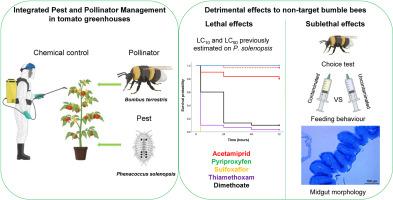用于控制棉粉蚧的杀虫剂对非目标熊蜂构成威胁。
IF 8.1
2区 环境科学与生态学
Q1 ENVIRONMENTAL SCIENCES
引用次数: 0
摘要
熊蜂(Bombus spp.,膜翅目,鳞翅目)在为温室番茄作物授粉方面发挥着至关重要的作用。然而,番茄生产不断受到各种入侵害虫的威胁,这些害虫往往导致杀虫剂使用量的增加,对传粉昆虫造成负面影响。最近,地中海番茄中出现了棉粉蚧 Phenacoccus solenopsis,对其进行化学防治也引起了人们对熊蜂的关注。在实验室中,我们评估了可能用于控制棉粉蚧的四种杀虫剂(啶虫脒、吡虫啉、磺草酮和噻虫嗪)对熊蜂的急性毒性和亚致死效应。磺胺草酮和噻虫嗪大大降低了熊蜂的存活率,而啶虫脒和吡虫啉则改变了熊蜂的取食行为,熊蜂无法检测到受污染的溶液。此外,暴露于啶虫脒的大黄蜂出现了神经中毒症状,暴露于啶虫脒和吡虫啉的大黄蜂中肠也发生了变化。这些结果表明,对熊蜂毒性较低的杀虫剂(如啶虫脒和吡虫啉)可对熊蜂造成亚致死效应,从而增加了对使用这些物质的担忧。我们的研究结果为在害虫和传粉昆虫综合管理的背景下通过化学害虫控制优化熊蜂授粉服务提供了宝贵的见解。本文章由计算机程序翻译,如有差异,请以英文原文为准。

Insecticides used for controlling cotton mealybug pose a threat to non-target bumble bees
Bumble bees (Bombus spp., Hymenoptera, Apidae) play a crucial role in pollinating greenhouse tomato crops. However, tomato production is constantly threatened by different invasive pests that often lead to the increased use of pesticides, with negative consequences for pollinators. The cotton mealybug Phenacoccus solenopsis has recently been reported in Mediterranean tomatoes and its chemical control raises concerns also regarding bumble bees. In the laboratory, we evaluated the acute toxicity and sublethal effects in B. terrestris workers exposed to the diet contaminated with four insecticides (acetamiprid, pyriproxyfen, sulfoxaflor, and thiamethoxam), potentially used to control P. solenopsis. Sulfoxaflor and thiamethoxam significantly reduced the survival of B. terrestris, while acetamiprid and pyriproxyfen altered its feeding behaviour, and the bumble bees were unable to detect the contaminated solution. Moreover, neurotoxic symptoms were observed in bees exposed to acetamiprid and alterations of the midgut were detected in bees exposed to both acetamiprid and pyriproxyfen. These results show that insecticides with low levels of toxicity to bumble bees (e.g. acetamiprid and pyriproxyfen), can cause sublethal effects on them, increasing concern about the use of these substances. Our findings provide valuable insights as regards optimizing bumble bee pollination services with chemical pest control within the context of Integrated Pest and Pollinator Management.
求助全文
通过发布文献求助,成功后即可免费获取论文全文。
去求助
来源期刊

Chemosphere
环境科学-环境科学
CiteScore
15.80
自引率
8.00%
发文量
4975
审稿时长
3.4 months
期刊介绍:
Chemosphere, being an international multidisciplinary journal, is dedicated to publishing original communications and review articles on chemicals in the environment. The scope covers a wide range of topics, including the identification, quantification, behavior, fate, toxicology, treatment, and remediation of chemicals in the bio-, hydro-, litho-, and atmosphere, ensuring the broad dissemination of research in this field.
 求助内容:
求助内容: 应助结果提醒方式:
应助结果提醒方式:


